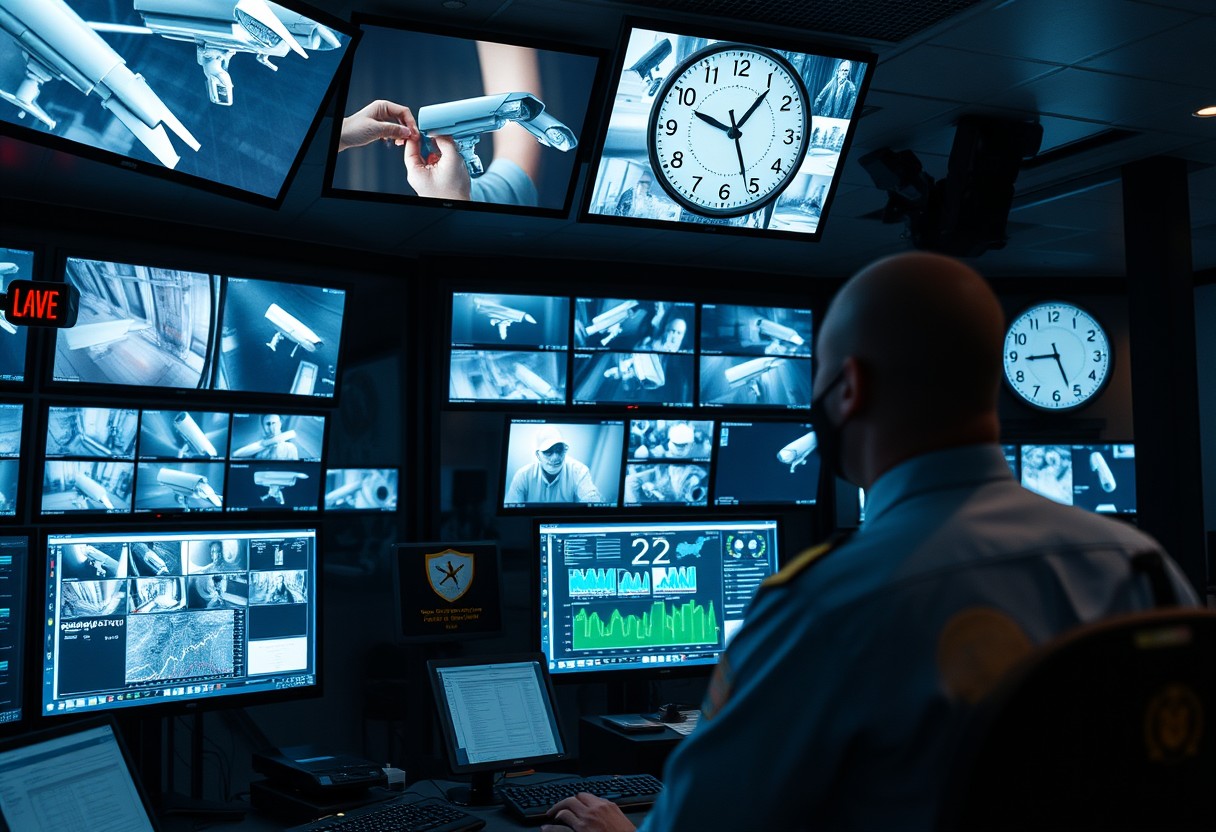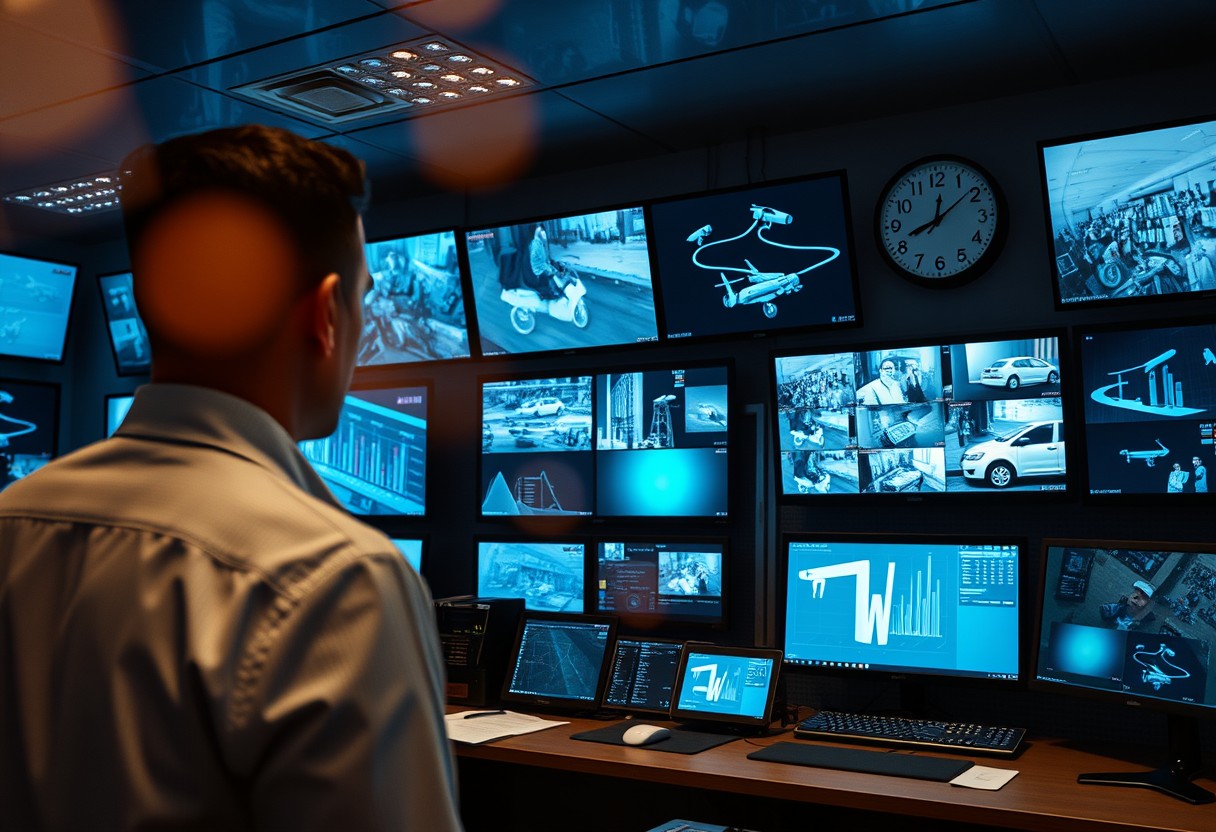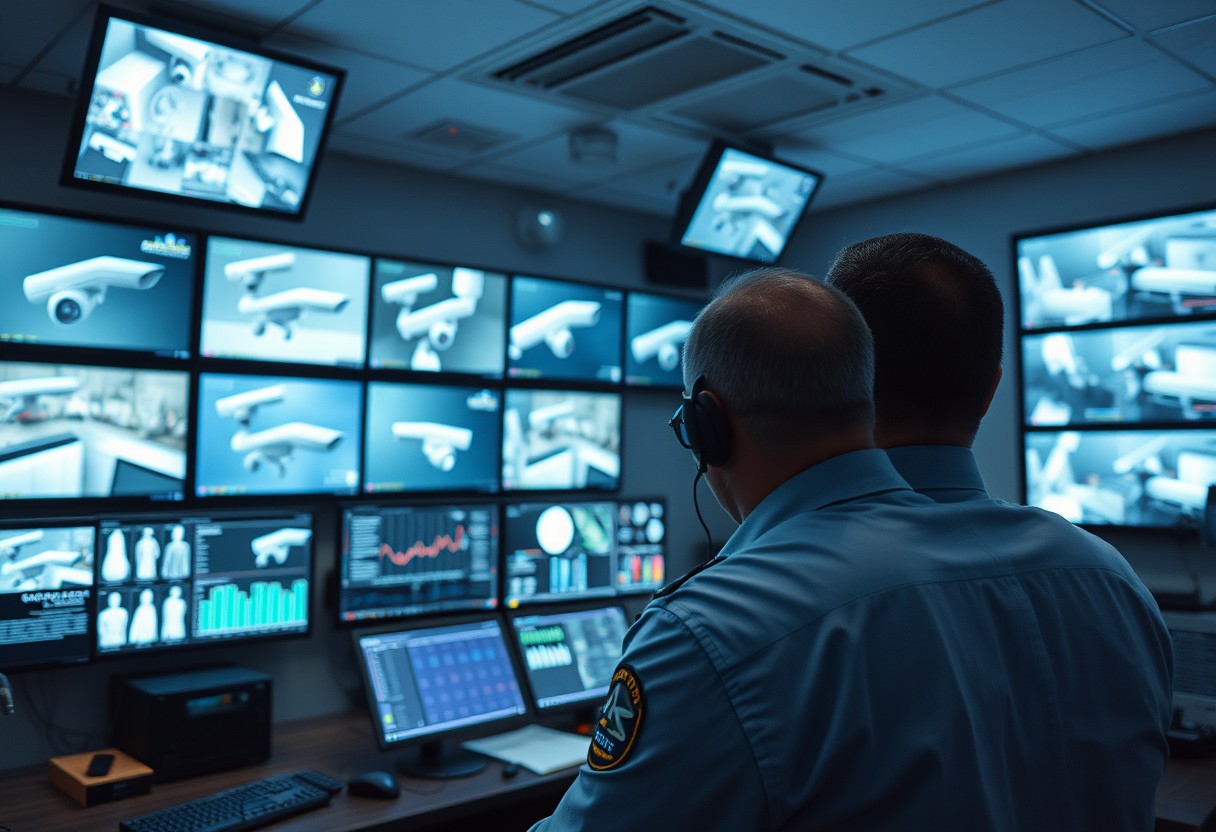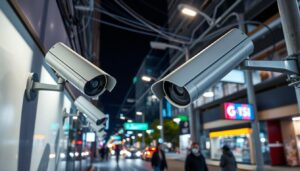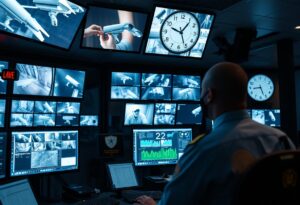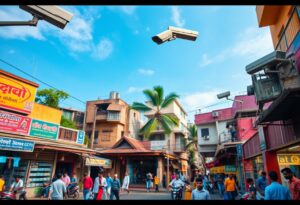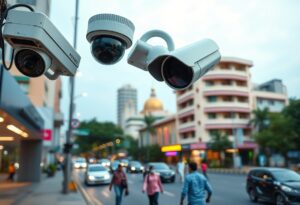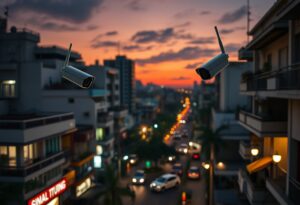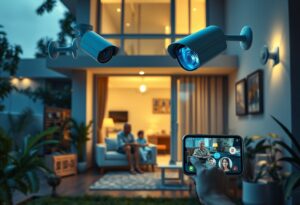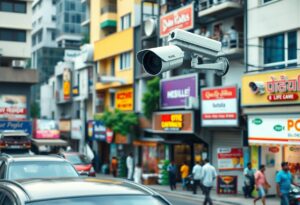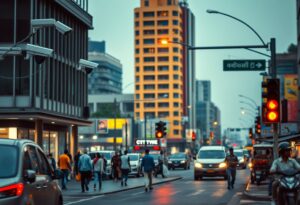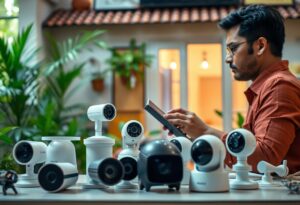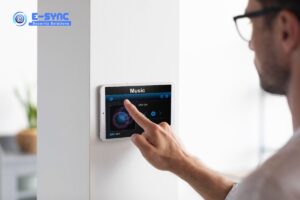There’s a pressing need for robust security measures in today’s world, and surveillance cameras play a crucial role in enhancing your safety. By implementing these devices, you not only deter potential criminal activity but also ensure accountability and vigilance in your environment. Surveillance cameras provide real-time monitoring and documentation, allowing you to take proactive steps in safeguarding your property and loved ones. In this blog post, we will explore how these technological advancements can elevate your security framework and foster a more secure living or working space.
Key Takeaways:
- Monitoring: Surveillance cameras provide continuous monitoring, allowing security personnel to keep an eye on critical areas at all times, thus improving response time to incidents.
- Deterrence: The presence of surveillance cameras serves as a strong deterrent against potential criminal activities, often preventing incidents before they occur.
- Evidence Collection: Recorded footage from surveillance cameras provides valuable evidence that can be used in investigations and court proceedings, enhancing the overall effectiveness of security measures.
- Remote Access: Many modern surveillance systems offer remote access capabilities, allowing security teams to monitor live feeds and review footage from anywhere, increasing operational efficiency.
- Data Analysis: Advanced surveillance technology can incorporate analytics tools that help identify patterns, track suspicious behavior, and contribute to proactive security measures.
The Evolution of Surveillance Technology
For decades, surveillance technology has played a pivotal role in enhancing security measures across various sectors. The journey of surveillance cameras has seen the integration of innovative technologies aimed at improving monitoring capabilities and decision-making processes. As you explore this evolution, you’ll find that the history of surveillance cameras paints an intriguing picture of how far we’ve come and how these advancements have shaped your modern security landscape.
Historical Overview of Surveillance Cameras
Overview of surveillance cameras dates back to the mid-20th century when rudimentary systems were developed primarily for military and government use. Early equipment consisted of analog cameras that recorded footage onto tapes, which made real-time monitoring a challenge. Over the years, these systems were adapted for civilian use, particularly in banks and retail establishments. As your understanding deepens, it’s important to recognize how these initial implementations laid the groundwork for the comprehensive surveillance frameworks we see today.
Advances in Camera Technology
The advent of digital technology in the late 20th and early 21st centuries transformed the principle of surveillance cameras as you know them. High-definition cameras emerged, offering clearer images that significantly improved facial recognition and monitoring capabilities. The introduction of features such as motion detection, low light recording, and remote access redefined the role of surveillance. Gone are the days of bulky tape players; instead, you now have the convenience of cloud storage and wireless integrations that enhance functionality while reducing the risk of data loss.
Another critical advancement has been the integration of artificial intelligence (AI) into surveillance systems. AI-driven cameras can analyze footage in real-time, allowing for immediate response to suspicious activities. These smart systems are capable of learning from the environment, improving their detection capabilities over time. As you navigate through various security solutions, understanding the importance of these advancements can help you make informed decisions about the systems most suited to your needs.
Integration with Modern Security Systems
Evolution in surveillance technology goes hand in hand with modern security systems. Today, you will find that surveillance cameras are not standalone devices; they are part of an interconnected network that provides layered security. These systems enable you to monitor various locations from a centralized point, enhancing your ability to react promptly to any threats encountered. The seamless integration of video surveillance with alarm systems, access controls, and other security measures forms a robust backbone for maintaining safety in residential and commercial spaces.
Understanding the complexities of these integrations is crucial as they provide added value to your security measures. By leveraging interconnected technologies, you can ensure that your surveillance cameras work in synergy with other security elements, amplifying their effectiveness. The result is a sophisticated security ecosystem that not only deters criminal activity but also enhances the overall diligence of your security protocols.
The Role of Surveillance Cameras in Crime Prevention
It is widely acknowledged that surveillance cameras play a critical role in modern security practices. These devices not only serve to monitor activities but also act as a proactive approach to crime prevention. The mere presence of cameras in public spaces creates an atmosphere of accountability, which can significantly influence the likelihood of criminal behavior occurring. When you see a camera, whether in a parking lot or a retail store, you are reminded that your actions are being watched, and this awareness can lead to more cautious behavior by the public.
Deterrence Effect on Criminal Behavior
Behavior modification is one of the primary effects of surveillance cameras. Studies have shown that areas equipped with video surveillance experience a notable decline in criminal activities. This is largely due to the sense of being observed and the fear of potential consequences that act as strong deterrents for would-be offenders. For you, this means that the presence of cameras can lead to safer environments, decreasing the likelihood of theft, vandalism, and other crimes in locations where they are installed.
Moreover, law enforcement agencies and security professionals consistently emphasize the efficacy of surveillance in discouraging criminal actions. When you recognize that you might be recorded, the risks associated with illicit activities far outweigh any potential benefits. This creates a collective consciousness that prioritizes safety and reduces the overall crime rates in monitored areas, benefiting the broader community.
Increased Perception of Safety Among Communities
Any community that adopts surveillance technology can witness an increase in its residents’ sense of safety. When individuals feel secure in their environment, they are more likely to engage in outdoor activities, socialize, and build a stronger communal bond. The visible presence of surveillance cameras reassures people that proactive measures are in place to protect them, enhancing confidence in local law enforcement and security protocols.
A growing body of research supports the notion that neighborhoods with active surveillance programs see not just lower crime rates but also improved community interactions. You might find that neighbors become more vigilant and cooperative when they know their surroundings are monitored. This creates a sense of unity, whereby citizens feel empowered and responsible for one another’s safety, leading to increased overall crime prevention.
Data-Driven Assessments of Crime Reduction
Crime rates can be significantly reduced through the analysis of data collected from surveillance cameras. When you examine patterns and trends in criminal activity, you can identify hotspots and areas that require more attention. This intelligence allows law enforcement to allocate resources more effectively, enhancing response times and ensuring that crime prevention strategies are tailored to the needs of the community.
For instance, data-driven assessments may reveal specific times when criminal activities peak, prompting your local authorities to ramp up patrols or improve lighting in those areas. Such targeted approaches can lead to noticeable declines in crime, as strategic enhancements are based on real-time evidence rather than assumptions. This creates a feedback loop where the continuous monitoring and evaluation of data contribute to effective long-term solutions for community safety.
Enhancing Incident Response and Investigation
Many organizations today understand that the integration of surveillance cameras not only acts as a deterrent but also plays a significant role in enhancing incident response and investigation capabilities. By constantly monitoring activities in both public and private spaces, these systems enable you to quickly identify and react to unusual occurrences, thereby mitigating risks before they escalate into more serious situations. As incidents unfold, real-time access to footage empowers security personnel to make informed decisions, ultimately streamlining the response process.
Real-Time Monitoring Capabilities
On a practical level, the real-time monitoring capabilities of surveillance cameras can significantly enhance your ability to address and resolve incidents as they happen. This immediate access to visual data allows you to quickly assess the situation and mobilize the appropriate response team, whether it’s security guards, law enforcement, or emergency services. Moreover, the integration of advanced features like motion detection and alerts can help notify you of suspicious activity instantly, ensuring that you are always one step ahead.
On the other hand, the effectiveness of real-time monitoring is greatly augmented by the use of high-definition cameras and cloud-based systems. These technologies allow you to access live feeds and recorded footage from virtually anywhere, giving you the flexibility to monitor multiple locations simultaneously. By leveraging these capabilities, you can ensure that no incident goes unnoticed, thus bolstering the overall security architecture of your environment.
Forensic Analysis and Evidence Collection
On top of enhancing real-time situational awareness, surveillance cameras also play an vital role in forensic analysis and evidence collection after an incident has occurred. When an event transpires, the recorded footage becomes a pivotal resource for reviewing what happened, identifying the individuals involved, and determining the causes and consequences. This thorough examination not only aids you in understanding the incident better but also equips you with the necessary evidence to support investigations or legal actions, should they be required.
Analysis of video footage can reveal critical elements such as the timeline of events, the actions of individuals, and potential witnesses present at the scene. By conducting a meticulous review, you can piece together a comprehensive account of the incident, which is invaluable for documentation and reporting purposes. This level of detail can be vital in various settings, whether it’s for internal reviews, insurance claims, or even court proceedings.
Integration with Law Enforcement and Emergency Services
An equally important aspect of surveillance cameras lies in their capability to integrate seamlessly with law enforcement and emergency services. When a situation requires immediate attention, having a system that can directly communicate with these external entities can drastically improve response times. For instance, as soon as suspicious activity is detected, you can share live feeds and relevant information with law enforcement, equipping them with context as they approach the scene.
Moreover, this integration fosters a cooperative approach to security, where your organization becomes an active participant in maintaining public safety. By establishing direct lines of communication, you can collaborate with local authorities to implement tailored strategies in crime prevention and emergency preparedness, ultimately creating a safer environment for everyone involved.
The partnership between surveillance systems and law enforcement not only strengthens your security measures but also enhances community trust. When citizens observe that organizations are actively engaging with local police for better security through technology, it provides reassurance that both public safety and civic responsibility are prioritized.
Privacy Considerations and Ethical Implications
Keep in mind that while surveillance cameras can significantly enhance security, they also raise important questions about privacy rights and ethical practices. The key challenge is to balance the need for safety with the fundamental right to privacy. As you navigate this landscape, understanding how surveillance measures affect personal freedoms is critical. You may find yourself weighing the perceived benefits of surveillance—such as crime deterrence and increased safety—against the potential for invasive monitoring and abuse of power.
Balancing Security and Personal Privacy
Implications arise when the lines between public safety and individual privacy begin to blur. For you, this can mean grappling with the complexities of whether surveillance cameras in public places constitute a reasonable expectation of privacy. For instance, while cameras may protect communal spaces, they can also record activities that some individuals would prefer to keep private. The ethical dilemma becomes more pronounced when watching innocent citizens, as the very technology designed for safeguarding can inadvertently make you feel scrutinized and exposed.
Legal Framework Governing Surveillance
Framework governing surveillance activities is crucial in maintaining a balance between security and privacy. Laws vary significantly across jurisdictions but often include regulations on how and when surveillance can occur, as well as guidelines on data storage and usage. This legal structure is designed to ensure that your privacy is respected while allowing for necessary security measures. You might be surprised to learn that many locations require signage to inform individuals about the presence of cameras, exemplifying an effort to honor personal privacy rights.
Legal systems worldwide are increasingly adapting to the rapid advancements in surveillance technology. Various laws often outline who has access to the footage, how long it can be stored, and the penalties for misuse. As you become familiar with these regulations, it’s vital to know your rights regarding surveillance, as well as the obligations of those implementing security measures. Awareness of these legal frameworks can empower you to advocate for more transparency and responsibility in surveillance practices.
Transparency and Public Trust in Surveillance Practices
Framework that emphasizes transparency in surveillance operations is crucial for fostering public trust. When you understand how your local authorities conduct surveillance and what measures are in place to protect personal data, it can alleviate concerns about potential abuses. Being informed about these practices can offer you peace of mind, while also fostering a sense of community and cooperation between law enforcement and civilians.
Understanding the importance of transparency is crucial for building trust. Open communication channels regarding the purpose, scope, and monitoring of surveillance cameras can demystify their presence in your community. By staying informed, you can better assess the effectiveness and ethical implications of surveillance systems in place and contribute to discussions about responsible practices that respect personal privacy while enhancing security.
Adaptation in Diverse Environments
Now, as security concerns continue to evolve, surveillance cameras have adapted to fit a multitude of environments, enhancing efficacy across various settings. One of the most significant distinctions in this adaptation occurs between public spaces and private properties, each requiring unique surveillance strategies. With public areas, such as parks, streets, and transit hubs, the focus often leans towards preventing crime and monitoring large crowds, allowing authorities to respond swiftly to incidents. In contrast, private properties necessitate a different approach, often prioritizing the protection of individual residences or businesses. Here, surveillance is customized to safeguard specific assets, control access points, and ensure the privacy of residents or patrons, creating a comprehensive security framework tailored to unique needs.
Surveillance in Public Spaces vs. Private Properties
Spaces like airports and shopping malls tend to deploy high-definition cameras equipped with advanced analytics that can detect unusual behavior or crowd surges. These systems help you maintain safety in real-time and gather vital information for future strategies. On the other hand, your home or business surveillance may include discrete cameras designed to blend into the environment while monitoring entry points and critical zones. This versatility allows for proactive threat assessment and incident management tailored to your specific risk profile.
Commercial Applications and Retail Security
Diverse industries have leveraged surveillance technology to address specific concerns in retail and commercial environments. In retail settings, surveillance cameras serve multiple purposes—dissuading shoplifting, monitoring employee performance, and gathering data on customer behavior. Your investment in these technologies pays dividends through both asset protection and increasing operational efficiency.
Adaptation in retail security enhances customer experience by ensuring a safe shopping environment while streamlining store operations. By implementing facial recognition and analytics software, you can better understand shopper preferences and traffic patterns, driving your marketing strategies. As a result, you not only deter theft but also create a more inviting shopping atmosphere that encourages repeat business.
Critical Infrastructure and Transportation Security
Surveillance systems play a crucial role in safeguarding critical infrastructure and transportation systems, such as airports, power plants, and highways. These environments necessitate rigorous security measures due to their complexity and the high stakes involved. Advanced camera setups allow you to monitor entrances, sensitive areas, and perimeters, enhancing overall situational awareness. By integrating these systems with other security measures, you can create a fortified network that proactively responds to potential threats, effectively maintaining safety on multiple levels.
For instance, airports utilize comprehensive surveillance systems to not only monitor passenger flow but also to detect unusual activities that may pose threats to aviation security. Automated systems are often employed to analyze crowd dynamics and potential hazards in real time, allowing for swift response by security personnel, ensuring the safety of countless passengers every day. Such adaptations enable you to safeguard critical assets and ensure uninterrupted service delivery in high-stakes environments.
How Do Surveillance Cameras Fit Into a Comprehensive Security System?
Surveillance cameras are vital for a comprehensive security system, capturing real-time footage that can deter criminal activity. When paired with alarms and access controls, they implement effective strategies for enhancing security systems, providing comprehensive coverage and monitoring. This multi-layered approach helps ensure safety in both residential and commercial properties.
Future Trends in Surveillance Technology
Your understanding of surveillance technology is crucial for appreciating its evolution and potential impact on modern security frameworks. As we continue to navigate an increasingly digital world, innovative trends are shaping the future of surveillance systems, making them more efficient, reliable, and user-friendly. With developments in artificial intelligence, smart cities, and emerging technologies, the landscape of security cameras is set to change dramatically, enhancing your ability to maintain safety and vigilance in a variety of settings.
Artificial Intelligence and Machine Learning Capabilities
Learning from vast amounts of data, artificial intelligence (AI) and machine learning are revolutionizing surveillance cameras. These systems can now learn to recognize patterns, differentiate between typical behavior and anomalies, and improve object and facial recognition. As a result, you can expect surveillance technology to become more proactive rather than merely reactive. This shift enables security measures to be put in place even before a potential threat manifests, increasing your security posture significantly.
Additionally, the integration of AI enables cameras to filter out false alarms caused by non-threatening movements, such as animals or environmental changes. This means that you can focus your attention more effectively on the relevant alerts that matter, streamlining your security operations. The capacity for continuous learning ensures that surveillance systems only improve over time, reflecting new statistics and data patterns that lead to enhanced predictive capabilities.
Smart Cities and IoT Integration
Smart technology is reshaping urban landscapes, and surveillance systems are integral to the development of smart cities. This integration focuses on the Internet of Things (IoT), allowing devices to communicate with each other, fostering a seamless flow of information. As a result, your environment becomes increasingly interconnected, where surveillance cameras can relay data to traffic lights, emergency services, and even city planners, enhancing public safety and infrastructure efficiency.
Smart cities leverage IoT-enabled surveillance cameras to gather data that can be analyzed to improve urban living. By monitoring crowd movement, traffic patterns, and environmental changes, you gain a comprehensive view of how your community functions. This information allows local authorities to make informed decisions regarding resource allocation, traffic management, and emergency response, ultimately contributing to a safer and more efficient urban area.
Emerging Technologies and Their Impact on Security
Impactful technologies such as drones, advanced analytics, and blockchain are also redefining the landscape of surveillance and security. Drones equipped with high-resolution cameras can monitor expansive areas that ground-based systems cannot easily cover, providing you a wider perspective on your security needs. Meanwhile, advanced analytics can process large volumes of data to deliver actionable insights, ensuring that you remain ahead of potential threats.
Moreover, the adoption of blockchain technology ensures secure storage and transmission of surveillance data. This gives you the peace of mind that your critical information is less susceptible to tampering or unauthorized access. The enhancement of both privacy and security through these emerging technologies is a game changer, as they form a robust foundation for future surveillance systems.
Emerging technologies will continue to shape the future of security, with a focus on improving efficiency and effectiveness. As you adapt to these changes, it’s crucial to stay informed about new tools and trends that can further enhance your diligence in protecting your home or business. By leveraging these advancements, you can create a more secure environment while maintaining control over your privacy and data security.
Summing up
Summing up, surveillance cameras serve as a pivotal enhancement to the modern security landscape, ensuring that your environment—be it personal or professional—remains secure and vigilant. By integrating these advanced monitoring systems, you not only deter potential threats but also create a sense of safety for yourself and those around you. The ability to capture real-time footage provides invaluable evidence in any incident that may occur, empowering you to respond swiftly and appropriately when necessary. With features like remote access and motion detection, you can keep an eye on your property no matter where you are, enabling you to maintain peace of mind in today’s fast-paced world.
Furthermore, the intelligent analytics offered by modern surveillance systems can significantly improve your security diligence. These systems are designed to analyze patterns and behaviors, alerting you to any irregular activities that may require your attention. As you harness these tools, you’re not just monitoring a space; you’re proactively managing your security strategy. By investing in surveillance technology, you position yourself to better protect what matters most, making it a crucial asset in your overall safety plan.
Q: How do surveillance cameras contribute to crime prevention?
A: Surveillance cameras act as a powerful deterrent to criminal activity. Their visible presence can discourage potential offenders from engaging in unlawful behavior. Studies have shown that areas equipped with surveillance cameras experience a significant reduction in crimes such as vandalism, theft, and burglary. Additionally, the knowledge that their actions are being recorded increases the likelihood that individuals will be held accountable, further enhancing proactive security measures.
Q: In what ways do surveillance cameras aid in incident response and investigation?
A: Surveillance cameras provide real-time monitoring and can assist in prompt incident response. Security personnel and law enforcement can access live feeds, allowing them to assess situations as they unfold and deploy appropriate resources quickly. Furthermore, recorded footage serves as valuable evidence in investigations, enabling authorities to analyze incidents, identify suspects, and build cases based on concrete visual data. This enhances both the efficiency and effectiveness of security measures in modern environments.
Q: How do advanced features of surveillance cameras enhance security diligence?
A: Modern surveillance cameras come equipped with advanced features such as motion detection, facial recognition, and night vision capabilities. These technologies enhance security diligence by enabling automated alerts in case of suspicious activity, allowing for a quicker response time. Additionally, facial recognition can help identify potential threats or individuals with restraining orders, making environments safer. The integration of analytics into surveillance systems allows for more responsive and intelligent security management, ultimately reinforcing the overall effectiveness of security protocols.

